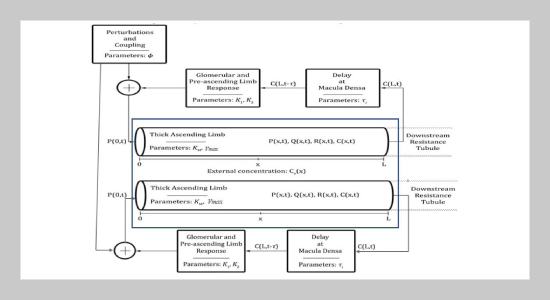REFERENCES
- [1] J. L. Laugesen, E. Mosekilde, and Z. T. Zhusubaliyev, (2012) “Bifurcation structure of the C-type perioddoubling transition" Physica D: Nonlinear Phenomena 241(5): 488–496.
- [2] J. L. Laugesen, O. V. Sosnovtseva, E. Mosekilde, N.-H. Holstein-Rathlou, and D. J. Marsh, (2010) “Couplinginduced complexity in nephron models of renal blood flow regulation" American Journal of Physiology-Regulatory, Integrative and Comparative Physiology 298(4): R997–R1006.
- [3] O. Sosnovtseva, D. Postnov, E. Mosekilde, and N.-H. Holstein-Rathlou, (2003) “Synchronization of tubular pressure oscillations in interacting nephrons" Chaos, Solitons & Fractals 15(2): 343–369.
- [4] N.-H. Holstein-Rathlou, K.-P. Yip, O. V. Sosnovtseva, and E. Mosekilde, (2001) “Synchronization phenomena in nephron–nephron interaction" Chaos: An Interdisciplinary Journal of Nonlinear Science 11(2): 417–426.
- [5] D. J. Marsh, D. D. Postnov, O. V. Sosnovtseva, and N.-H. Holstein-Rathlou, (2019) “The nephron-arterial network and its interactions" American Journal of Physiology-Renal Physiology 316(5): F769–F784.
- [6] D. J. Marsh, D. D. Postnov, D. J. Rowland, A. S. Wexler, O. V. Sosnovtseva, and N.-H. Holstein-Rathlou, (2017) “Architecture of the rat nephron-arterial network: analysis with micro-computed tomography" American Journal of Physiology-Renal Physiology 313(2): F351–F360.
- [7] D. J. Marsh, O. V. Sosnovtseva, K. H. Chon, and N.-H. Holstein-Rathlou, (2005) “Nonlinear interactions in renal blood flow regulation" American Journal of Physiology-Regulatory, Integrative and Comparative Physiology 288(5): R1143–R1159.
- [8] D. J. Marsh, O. V. Sosnovtseva, A. N. Pavlov, K.-P. Yip, and N.-H. Holstein-Rathlou, (2005) “Frequency encoding in renal blood flow regulation" American Journal of Physiology-Regulatory, Integrative and Comparative Physiology 288(5): R1160–R1167.
- [9] D. J. Marsh, O. V. Sosnovtseva, E. Mosekilde, and N.-H. Holstein-Rathlou, (2007) “Vascular coupling induces synchronization, quasiperiodicity, and chaos in a nephron tree" Chaos: An Interdisciplinary Journal of Nonlinear Science 17(1): 015114.
- [10] D. J. Marsh, A. S. Wexler, A. Brazhe, D. E. Postnov, O. V. Sosnovtseva, and N.-H. Holstein-Rathlou, (2012) “Multinephron dynamics on the renal vascular network" American Journal of Physiology-Renal Physiology 304(1): F88–F102.
- [11] N.-H. Holstein-Rathlou and P. Leyssac, (1986) “TGFmediated oscillations in the proximal intratubular pressure: differences between spontaneously hypertensive rats and Wistar-Kyoto rats" Acta Physiologica 126(3): 333–339.
- [12] S. P. Kuznetsov, (2005) “Effect of noise on the dynamics at the Torus-doubling terminal point in a quadratic map under quasiperiodic driving" Physical Review E 72(2): 026205.
- [13] J. L. Laugesen, (2011) “Modelling Nephron Autoregulation and Synchronization in Coupled Nephron Systems" Technical University of Denmark (DTU), PhD thesis:
- [14] A. S. Pikovsky, M. G. Rosenblum, G. V. Osipov, and J. Kurths, (1997) “Phase synchronization of chaotic oscillators by external driving" Physica D: Nonlinear Phenomena 104(3-4): 219–238.
- [15] A. Pavlov, O. Pavlova, A. Koronovskii, and A. Hramov, (2018) “Effect of measuring noise on scaling characteristics in the dynamics of coupled chaotic systems" Chaos, Solitons & Fractals 116: 106–113.
- [16] O. V. Sosnovtseva, A. N. Pavlov, E. Mosekilde, K.-P. Yip, N.-H. Holstein-Rathlou, and D. J. Marsh, (2007) “Synchronization among mechanisms of renal autoregulation is reduced in hypertensive rats" American Journal of Physiology-Renal Physiology 293(5): F1545–F1555.
- [17] A. Aljuboori, L. A. Tawfeeq, and K. A. Al-Karawi, (2021) “Pushing towards ehealth for iraqi hypertensive: an integrated class association rules into SECI model" Indonesian Journal of Electrical Engineering and Computer Science 22(1): 522–533.
- [18] K. Nishinari and D. Takahashi, (1998) “Analytical properties of ultradiscrete Burgers equation and rule-184 cellular automaton" Journal of Physics A: Mathematical and General 31(24): 5439.
- [19] M. Murata, (2013) “Tropical discretization: ultradiscrete Fisher–KPP equation and ultradiscrete Allen–Cahn equation" Journal of Difference Equations and Applications 19(6): 1008–1021.
- [20] K. Matsuya and M. Murata, (2015) “Spatial pattern of discrete and ultradiscrete Gray-Scott model" Discrete & Continuous Dynamical Systems-B 20(1): 173.
- [21] Wolfram, Stephen, (1984) “Computation theory of cellular automata" Communications in Mathematical Physics 96(1): 15–57.
- [22] Wolfram S. A new kind of science. 5. Wolfram Media Champaign, IL, 2002.
- [23] S. Wolfram. Cellular automata and complexity: collected papers. CRC Press, 2018.
- [24] H. Ryu. “Feedback-Mediated Dynamics in the Kidney: Mathematical Modeling and Stochastic Analysis". (phdthesis). Duke University, 2014.
- [25] S. M. R. Kesu and H. Ramasangu, (2022) “Cellular automata model for emergent properties of pressure flow in single nephron compliance tubule" Indonesian Journal of Electrical Engineering and Computer Science 25(3): 1227–1235.
- [26] A. T. Layton and A. Edwards, (2014) “Mathematical Modeling in Renal Physiology" Springer ISBN 978-3-642-27367-4: VIII, 221 Pages.
- [27] G.W. Flake. The computational beauty of nature: Computer explorations of fractals, chaos, complex systems, and adaptation. MIT press, 2000.
- [28] J. M. Gutiérrez and A. Iglesias, (1998) “Mathematica package for analysis and control of chaos in nonlinear systems" Computers in Physics 12(6): 608–619.
- [29] Wolfram, Stephen and Mallinckrodt, A John, (1995) “Cellular automata and complexity" Computers in Physics 9(1): 55–55.
- [30] A. T. Layton, M. Bowen, A. Wen, and H. E. Layton, (2011) “Feedback-mediated dynamics in a model of coupled nephrons with compliant thick ascending limbs" Mathematical biosciences 230(2): 115–127.









